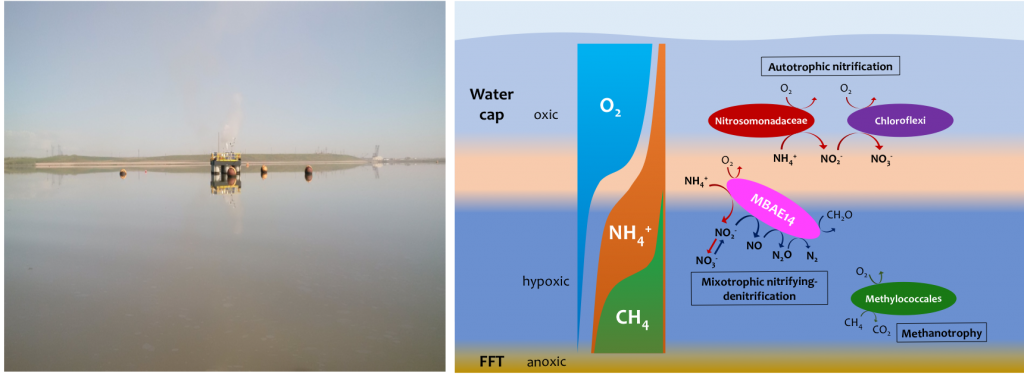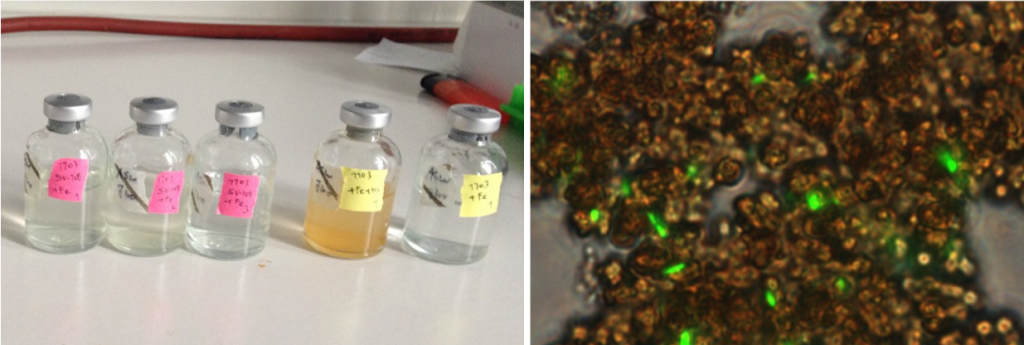Current Research
In the Mori Lab @YCU, several research projects in microbial ecology, microbial genomics, geomicrobiology, and bioremediation studies have got under way.
Current Research Interests:
(1) Petroleum hydrocarbon-degrading (soil/marine) microbial assemblages
(2) Interactions between marine microorganisms and plastic debris
(3) Iron-/manganese-oxidizing microorganisms in metal-rich groundwater outflow
(4) Filterable (ultra-small) microorganisms in coastal environments
今興味があること:
(1) 石油系炭化水素を生分解する(土壌/海洋)微生物群集
(2) 海洋微生物とプラスチックの関係
(3) 淡水環境中の鉄/マンガン酸化微生物の生態とその応用
(4) 除菌フィルターを通過する(超微小)海洋微生物
In-depth genomic characterization of petroleum hydrocarbon-degrading microorganisms

Microorganisms that can degrade petroleum hydrocarbons (alkanes and aromatic hydrocarbons) and utilize them as carbon and energy sources are considered to have acquired and conserve unique functional gene sets which encode specific enzymes that are responsible for bio-transformation of these hydrocarbons in their genomes.
Through complete genome sequencing and comparative genomics analyses, we conduct in-depth genomic characterization of selected petroleum hydrocarbon-degrading microorganisms, for the purpose of identifying key functional genes in their genomes and discovering their novel metabolic potentials.
石油に含まれる各種炭化水素(アルカンや芳香族炭化水素)を分解し、炭素源・エネルギー源として利用できる微生物は、それらの分解機構に関わる特殊な酵素群をコードする遺伝子群を獲得し、ゲノム上に保持しています。
それらの微生物について、次世代シーケンサーによるゲノムの完全解読、および既知の微生物との比較ゲノミクスを行うことにより、機能性遺伝子群の分布や、新規の代謝機能等について調査しています。
Related research articles:
Kayama et al., Microbiology Spectrum (2022)
Mori and Kanaly, Microbiology Spectrum (2022)
Complete genome announcements:
Abe et al., Marine Genomics (2023)
Kayama et al., Microbiology Resources Announcement (2022)
Mori et al., Microbiology Resources Announcement (2021)
Mori and Kanaly, Microbiology Resources Announcement (2021)
Presentations:
Mori et al., ASME/JSME, Hamamatsu (2023)
Abe et al., JSME, Hamamatsu (2023)
Multispecies petroleum hydrocarbon biodegradation ‘ignited’ by pioneering bacteria in a soil bacterial consortium

Microorganisms that are capable of biodegrading petroleum hydrocarbons and utilizing them as carbon and energy sources have been attracting interest for their potential roles in bioremediation. In natural environment, cooperative activities of multiple microbial groups are considered to be required to eliminate complex oil pollutant mixtures (alkanes and aromatic hydrocarbons), rather than a single microbial species.
Our lab employs a combined metagenomic functional gene analyses and culture-based characterizations of the metabolic capabilities for the oil-degrading bacterial consortium members, to understand their complex roles and interactions developed during oil exposure.
Our recent study using a diesel fuel-degrading soil bacterial consortium revealed that two pioneering members in the consortium, aromatics-degrading Sphingobium and alkane-degrading Pseudomonas, were responsible for initiating hydrocarbon biotransformations as well as the creation of specialized niches that were occupied by other bacterial members (co-colonizers). Co-existence of a select few pioneers and a multispecies co-colonizers cohort may be a common trait in natural ecosystems exposed to oil pollution.
石油を構成する各種炭化水素(アルカンや芳香族炭化水素)の多くは、急性毒性や変異原性(発ガン性)を持つため、石油の大規模な流出は周辺の生態系に深刻な影響を与えます。そこで、石油系炭化水素をエネルギー源・炭素源として利用し、これらを生分解する能力を持つ微生物が注目を集めています。複雑な混合物である石油の完全な生分解のためには、複数種の微生物の共存が必要であると考えられています。
我々の研究室では、メタゲノム解析による微生物の機能性遺伝子群の解析、および培養した微生物の増殖能・代謝産物の分析という2つのアプローチにより、複雑な石油分解微生物群集における各微生物種の役割や相互作用機構の解明を目指しています。
優れたディーゼル油生分解能を持つ土壌細菌群集を用いた最新の研究では、芳香族分解細菌Sphingobium属とアルカン分解細菌Pseudomonas属という2群の「パイオニア微生物」がいち早く炭化水素の分解を始め、その食べ残しや代謝産物に依存して他の多くの細菌種が増殖していたことを証明しました。こうした、少数のパイオニア微生物に支えられた微生物生態系が、石油汚染環境において普遍的に構築されているのかもしれません。
Related research article:
Mori and Kanaly, Applied and Environmental Microbiology (2020)
Presentations:
Mori et al., JSME, Sapporo (2022)
Kayama et al., JSME, Niigata (2021)
Mori et al., JSME, Yamanashi (2019)
Ecology of freshwater Mn-oxidizing microorganisms; evaluation of their potentials for water purification
A variety of microorganisms (bacteria and fungi) have the ability to oxidize dissolved Mn(II) and precipitate it as Mn(III/IV) oxides. The Mn oxides produced by these microorganisms, the so-called Biogenic Mn Oxides (BMOs), are known to adsorb other heavy metals, and therefore are considered to have a potential to clean-up toxic heavy metal pollutants in water environments.
Our current mission is to characterize the biomineralization and bioremediation potentials of a new Mn(II)-oxidizing fungal isolate, which was obtained from a Mn(II)-rich freshwater outflow located near the YCU campus.
微生物が水中のMn(II)を酸化しMn(III/IV)酸化物として沈殿させる能力は、多様な系統の細菌・真菌で報告されています。微生物が産生するMn(III/IV) 酸化物 (Biogenic Mn Oxides, BMOs)は他の重金属を吸着することから、マンガン酸化微生物が水中の有毒な重金属を沈殿させることで、水環境を浄化する能力をもつと期待されます。
本学周辺の淡水環境から単離した新規のマンガン酸化真菌は、産生したBMOを菌糸上に点在させるユニークな性質をもち、さらにこれらのBMOが他の重金属を吸着することを、物理学系研究室との協力により可視化することに成功しました。
Related research article:
Tsushima et al., coming soon…
Genome announcement:
Tsushima et al., Microbiology Resource Announcements (2023)
Presentation:
Tsushima et al., JSME, Sapporo (2022)
Past Research Projects
Microbial ecology in the Canadian oil sands first large-scale end pit lake in Athabasca, Alberta
(2017-2019, supervised by Prof. Lesley Warren, University of Toronto/McMaster University)

Our combined metagenomic and geochemical survey revealed the presence of putative novel mixotrophic nitrifying-denitrifying bacteria, which dominantly inhabit the ammonia/oxygen transition zone of the world-first oil sands mining pit lake in the Athabasca oil sands region (Alberta, Canada).
Collaborators: Jill Banfield, Lin-Xing Chen (UC Berkeley), Matt Lindsay, Joyce McBeth (Univ. Saskatchewan)
世界で唯一のオイルサンド採掘ピット湖(カナダ・アルバータ州)に生息する微生物群集に対してメタゲノム解析を行い、硝化・脱窒の”二刀流”をこなす新規の細菌の存在を提唱しました。
Related research article:
Jessen et al., Microorganisms (2022)
Mori et al., Frontiers in Microbiology (2019)
Chen et al., mSystems (2019)
Presentation:
Mori et al., ISME17, Leipzig (2018)
Discovery and characterization of Ghiorsea, a novel genus of Zetaproteobacteria
(2015-2017, supervised by Dr. David Emerson, Bigelow Laboratory for Ocean Sciences)

We isolated new genus of Zetaproteobacteria from deep ocean (Mid-Atlantic Ridge and Mariana back-arc), that can utilize molecular hydrogen as sole electron donor (in addition to ferrous iron). It is the first report of the hydrogen-oxidizing capability within the class Zetaproteobacteria.
Collaborators: Craig Moyer, Kevin Hager (Western Washington Univ.)
鉄(II)酸化能に加えて水素酸化能を有するゼータプロテオバクテリアの新属を深海から発見・単離し、詳しい培養試験とゲノム解析を行いました。
Related research article:
Mori et al., The ISME Journal (2017)
Fe-rich pelagic lake aggregates (“iron snow”) generated by the Fe-cycling bacterial team
(2013-2017, supervised by Prof. Kirsten Küsel, Friedrich-Schiller-University Jena)

Pelagic lake aggregates enriched with Fe-oxides (called iron snow) are formed by the simple bacterial community inhabiting in an acidic, Fe-polluted former lignite mining pit lake in Eastern Germany. These lake aggregates can be considered as a simplified model of bacterial interactions in the pelagic communities. We isolated a novel unique Fe-oxidizing bacterium Acidithrix, which plays a central role to form iron-rich aggregates. Additionally, potential chemical cross-talking, co-aggregation system evolved between Acidithrix and Fe-reducing Acidiphilium was revealed by our metabolomics study, which is a rare example of bacterial inter-species chemical communication.
Collaborators: Georg Pohnert, Nico Ueberschaar, Kai Uwe Totsche, Matthias Händel, Jürgen Popp, Nicolae Tarcea (FSU Jena), Thomas Neu (Helmholtz Centre UFZ)
ドイツ東部の旧褐炭鉱山ピット湖において鉄リッチな凝集体を形成するユニークな鉄酸化細菌Acidithrixを単離しました。また、Acidithrixと共存する鉄還元細菌Acidiphiliumが化学物質を介して情報伝達をしており、共凝集している現象をメタボロミクス解析により明らかにしました。これは、異種細菌間での化学コミュニケーション機構を報告した希少な例となりました。
Related research article:
Mori et al., The ISME Journal (2017)
Mori et al., Microbiology (2016)
Presentation:
Mori et al., ISME16, Montreal (2016)
Mori et al., Goldschmidt2016, Yokohama (2016)
Mori et al., Gordon Research Conference, Applied and Environmental Microbiology, Mount Holyoke (2015)
Streamer-forming algae-mineral-bacteria assemblages in heavy metal-polluted groundwater outflow
(2013-2015, supervised by Prof. Kirsten Küsel, Friedrich-Schiller-University Jena)

Conspicuous, streamer-forming microbial assemblages were observed in a former uranium-mining district in Eastern Germany. Our microbial community analyses and microscopic visualization revealed that the dominant Fe-oxidizing bacterium Gallionella were colonizing macroscopic green algae Tribonema, presumably utilizing algal exopolymer (i.e. EPS) to stick and dump the Fe-oxides.
Collaborator: Thomas Neu (Helmholtz Centre UFZ), Kai Uwe Totsche, Matthias Händel (FSU Jena)
ドイツ東部の旧ウラン鉱山では高濃度の重金属を含む地下水が滲出しており、そこで活発に生育しているGallionella属の鉄酸化細菌は多細胞藻類Tribonemaにべったりとまとわりついていました。顕微鏡で観察したところ、藻類が作る細胞外多糖(いわゆるEPS)を細菌が利用し、産生した酸化鉄を蓄積させていることも示唆されました。
Related research article:
Mori et al., Biogeosciences (2015)
Presentation:
Mori et al., ISME15, Seoul (2015)
